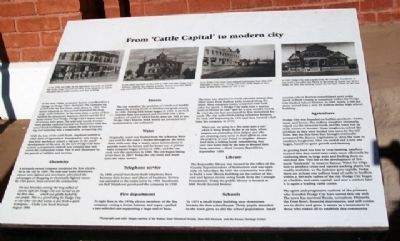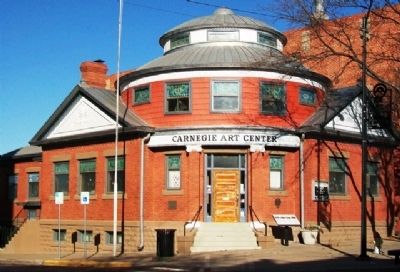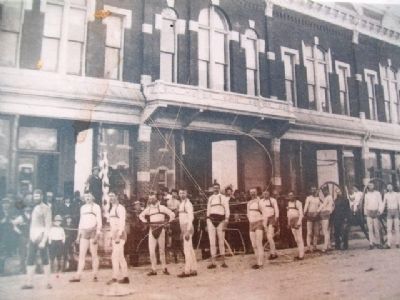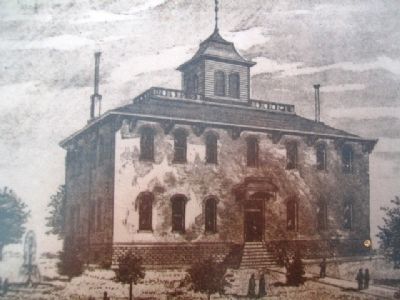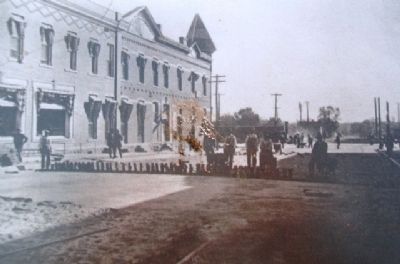Dodge City in Ford County, Kansas — The American Midwest (Upper Plains)
From 'Cattle Capital' to modern city
Inscription.
In the mid 1880s, economic factors contributed to a change in Dodge City's character. The cowtown era ended with the last Texas cattle drives in 1885. Two severe blizzards in that period destroyed the local range cattle industry. At the same time, a series of fires burned the downtown business district and the U.S. Army closed Fort Dodge. Dodge City's major sources of revenue were gone. The wild and woolly frontier town quickly replaced burned-out businesses with fire-proof brick buildings and began the task of recovering and maturing into a respectable, prospering city.
With the loss of the cattle trade, emphasis turned to other types of agriculture. Immigration, new crops, and farm machinery played a big part in the rapid development of the area. As the new Dodge City blossomed, a progressive attitude was revealed that still serves the community today. This is well illustrated by the growth of utilities and services.
Electricity
A privately-owned company produced the first electricity in the city in 1886. The next year some downtown streets were lighted and merchants advertised the advantages of shopping in electrically-lighted stores. By 1904 power lines covered the community.
On last Saturday evening the long talked of electric light for Dodge City was turned on for the first time...which was gladly hailed by our people. This is a grand thing for Dodge City, or any other city that wants to put forth a spirit of progress.
- Globe Live Stock Journal, August 1886
Streets
The city remedied the problem of rutted and muddy streets by levying funds to develop and grade streets in 1886. Paving with bricks began in 1913. A six-inch concrete base was poured and overlaid with a thin cushion of sand on which the bricks were set. Still in use, Dodge City's historic brick streets are protected by city ordinance.
Water
Originally, water was hauled from the Arkansas River and sold for five cents a bucket throughout the town. Soon wells were dug at major street intersections to provide water for horses and for home use. A private water company began service in 1887, and the city took over the operation in 1910. The city began laying sewer lines in 1887. Today the city owns and maintains the water service.
Telephone service
In 1880 several merchants built telephone lines between their homes and places of business. Service was extended to the entire town by 1904. Southwestern Bell Telephone purchased the company in 1920.
Fire department
To fight fires in the 1870s, eleven members of the fire company - using a breast harness and ropes - pulled a two-wheeled cart supporting a large reel of hose.
The
hose was attached to hand-operated pumps that lifted water from shallow wells located along the street. Hose company teams competed with each other for speed. A Dodge City team won a tournament at Denver in 1887 and set a new world's record. By 1914 the city had purchased its first motorized fire truck. The city authorized paying volunteer firemen for each call beginning in 1921 and then formed a full-time fire company in 1936.
When you are going to a fire never pass a cart which is being drawn by five or six men, whose tongues are protruding from fatigue and who are straining every nerve in their efforts to save the property of your friend or neighbor. Always lend them a helping hand, remembering that your own home may be the next to demand their hasty attention.
- Ford County Republican, September 1888
Library
The first public library was located in the office of the County Superintendent of Instruction and was open only on Saturdays. By 1907 the community was able to build a new library building on the corner of Second and Spruce streets using funds from the Carnegie Foundation. Today the public library is located at 1001 North Second Avenue.
Schools
In 1873 a small frame building near downtown became the first schoolhouse. Thirty pupils attended. As the town grew, so did the school population. Small country school
districts consolidated until today much of Ford County is contained within the Dodge City Unified School District. In 2001 nearly 1,500 students moved into a new 35-million-dollar high school building.
Agriculture
Dodge City was founded on buffalo products - hides, meat, and bones. The endless slaughter eventually wiped out the immense herds and the town lost its main source of income. Texas longhorns solved the problem as they were herded into town by the millions. But the tick-fever they brought eventually prompted the Kansas Legislature to close the state to southern longhorns. One era ended and a new one began, based on quiet growth and farming.
As grazing land was lost to crop farming, ranchers learned that they could raise cattle more efficiently by confining them in large pens and feeding them an enriched diet. This led to the development of livestock "feedyards" in western Kansas. Water for irrigation to produce crops and operate packing plants was readily available, so the industry grew rapidly. Today there are at least one million head of cattle in feedlots within a 100-mile radius of the city. Dodge City began as a buffalo and cattle capital, and over a century later it is again a leading cattle center.
The spirit and progressive outlook of the pioneers who founded Dodge City have served this city well. The town has survived floods,
tornadoes, blizzards, the Dust Bowl, financial depressions, and still continues to thrive and grow. It serves as a monument to those who risked all to establish this community.
Photographs and other images courtesy of the Kansas State Historical Society, Boot Hill Museum, and the Kansas Heritage Center
Topics. This historical marker is listed in these topic lists: Agriculture • Animals • Industry & Commerce • Settlements & Settlers. A significant historical year for this entry is 1885.
Location. 37° 45.274′ N, 100° 1.153′ W. Marker is in Dodge City, Kansas, in Ford County. Marker is at the intersection of 2nd Avenue and Spruce Street, on the left when traveling north on 2nd Avenue. Touch for map. Marker is at or near this postal address: 702 North 2nd Avenue, Dodge City KS 67801, United States of America. Touch for directions.
Other nearby markers. At least 8 other markers are within walking distance of this marker. Carnegie Library Building (here, next to this marker); The Reading Garden (within shouting distance of this marker); Hugh O'Brian (within shouting distance of this marker); Gene Barry (about 300 feet away, measured in a direct line); Milburn Stone (about 400 feet away); Charles Rath (about 500 feet away); Dennis Weaver (about 500 feet away); Wild and woolly Front Street (about 600 feet away). Touch for a list and map of all markers in Dodge City.
Also see . . .
1. Cowtowns. (Submitted on May 16, 2013, by William Fischer, Jr. of Scranton, Pennsylvania.)
2. Dodge City, Kansas, Official Website. (Submitted on May 16, 2013, by William Fischer, Jr. of Scranton, Pennsylvania.)
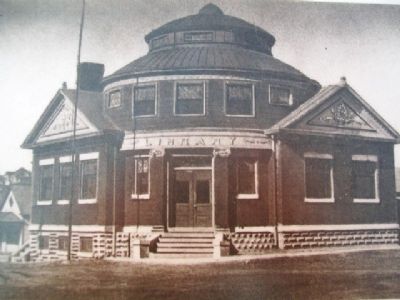
Photographed By Unknown, undated
6. Image on From 'Cattle Capital' to modern city Marker
[Caption reads] In 1907 Dodge City used a grant from the Carnegie Foundation to help build a beautiful new library at the corner of Second and Spruce streets. In 2003 this building housed the Carnegie Center for the Arts.
Credits. This page was last revised on March 22, 2021. It was originally submitted on May 15, 2013, by William Fischer, Jr. of Scranton, Pennsylvania. This page has been viewed 828 times since then and 55 times this year. Photos: 1, 2, 3, 4, 5, 6. submitted on May 16, 2013, by William Fischer, Jr. of Scranton, Pennsylvania.
